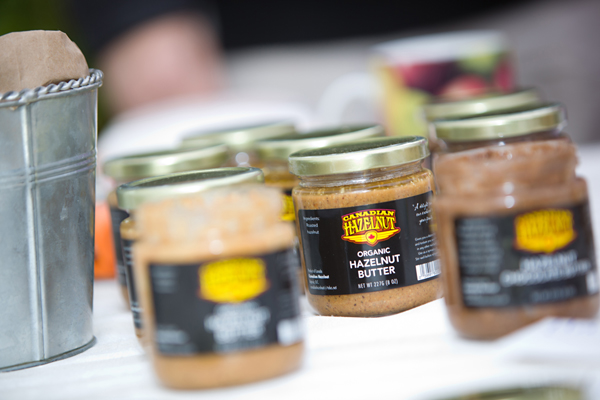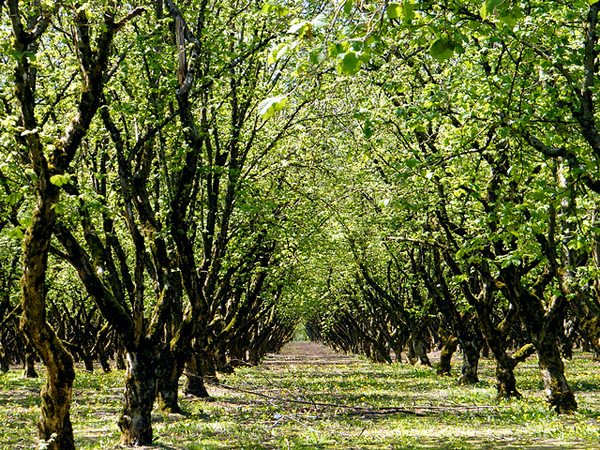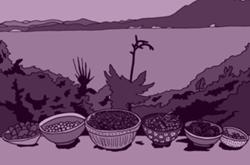
I've rationed myself just a quarter-teaspoon of Canadian Hazelnut Inc.'s chocolatey spread each day because I know, for the foreseeable future, there's no more where this came from -- this being not the sickeningly sweet, mass-marketed version of hazelnut butter (ahem, Nutella), but a deliciously rich mixture of local hazelnuts, grown in B.C.'s Fraser Valley.
The only major commercial nut production in Canada has been virtually wiped out, and with little ado, it seems. Despite pruning and spraying efforts by local farmers, Eastern Filbert Blight has crept north from Oregon and Washington states, and the airborne fungal disease has finally overtaken Fraser Valley hazelnut orchards.
Commercial production in this area dates to the 1930s, and since the 1980s it's where 95 per cent of Canada's hazelnuts have been grown. Five years ago, more than a million pounds of nuts were produced in the area. This year's yield predictions are less than one per cent of that.
''Contrast what's happened here with how Oregon handled the blight. Their industry is much larger -- they've been able to survive and grow blight-resistant trees. But they have a whole different level of government and institutional support,'' says Ben Ernst, owner of Vancouver's Earnest Ice Cream, whose popular flavour, Whiskey Hazelnut, is made with local nuts.
Ernst's supplier is Canadian Hazelnut Inc. in Agassiz, one of two nut processors in B.C. It's also a farm, where nearly 8,000 blight-infected trees were removed in March. The processor's well-visited retail store will close on June 1 when stocks run out. Rather than shoulder the time and expense of replanting the trees, the owners opted to sell the property.
A solution to the crisis is in blight-resistant tree varieties, developed at Oregon State University. But the seedlings, in high demand, are expensive and hard to access. ''Only two people in B.C. are producing these seedlings because there's a quarantine on at the border to try and stop the spread of the blight,'' says Shelley Krahn, a manager with Canadian Hazelnut Inc.
New varieties are being brought into Canada as tissue culture by biologist Dr. Thom O'Dell and his partner at Nature Tech Nursery in Langley. But it takes about two years to order and produce a tree that's ready for commercial planting. The bottom line? It will take patience and funding to restore the industry, and growers are not inclined to bear the blight alone.
'We've got very little help'
Hazelnuts are well suited to the Pacific Northwest. They thrive in a mild but not-too-warm winter. They wind-pollinate and, as is the case in Turkey and other commercial nut-producing areas of the world, they grow well near large bodies of water.
Not only are hazelnuts a good fit, and among the earliest pollinizers available to bees, but NDP MLA and agriculture critic Lana Popham argues that they're an important component of the province's long-term food security plan.

A report released in March by the BC Hazelnut Growers Association is awaiting action on a call for government to support a replant program. The program would cost $240,000 per year, helping offset the cost of replanting blight-resistant varieties for a total of $1.2 million over five years.
''We've been talking to the government for years over this disaster that's striking us, and so far we've got very little help," says Peter Andres, past president of the growers association who was involved with the organization for 30 years. "Seabird Island, the First Nations reserve a couple of miles out of Agassiz, is the largest orchard in Canada. Their trees are all dead. They're pulling them out as well. That's 120 acres.''
More than 20 years ago, Eastern Filbert Blight threatened to devastate orchards in Oregon, where 99 per cent of the U.S. hazelnut crop is grown. Oregon State University researchers began crossbreeding tree varieties and have since released 18 cultivars that are disease-resistant and high-yielding. Today, thousands of acres in Oregon are planted with these varieties.
Around the year 2000, the blight came across the U.S. border from Washington State and infected the Abbotsford area, mostly backyard trees, Andres says. "Once it got into orchards, there were lots of spores, and they started going up the Fraser Valley the way the wind blows, devastating orchards from about 2008 onwards. It reached Agassiz, which is the most eastern point, in about 2009 or 2010, and since then it has basically killed all the orchards in the Fraser Valley.''
Trials growing slowly
In 2010, the BC Hazelnut Growers Association, the Investment Agriculture Foundation and Nature Tech Nursery partnered to trial six new varieties in B.C., and the first batch of blight-resistant tissue cultures were imported from Oregon.
There are now six orchards in B.C. with trials of these new varieties. ''The trials are doing very well. I have 750 trees in my orchard. There are two others in Agassiz that have trials, two in Chilliwack and one on Hornby Island, because Vancouver Island is also starting to be infected,'' Andres says.
The trials, planted in 2011, are expected to produce little this year. ''Hopefully by next year, there might be enough nuts available for sharing with a neighbour, but usually it takes seven years for orchards to get to a position where you can harvest them and put them through a processing facility. It takes about 10 years for more or less good maturity,'' Andres says.

Support for a provincial replant program, says new growers association president Neal teBrinke, would allow the B.C. hazelnut sector to rebound with new zest.
''We as the farmers are willing to take the trees out, which is a huge cost, to re-level the land, and we're willing to babysit that tree for five or 10 years. All we're asking for is that they pay for the tree, which is $12, roughly... $1.2 million will put a thousand acres back into production, with more production per acre, and we'll have a viable nut industry that will do well here,'' says teBrinke.
Similar, though much larger, replant programs have been instituted for the province's apple and grape sectors to help facilitate the switch to more suitable or popular varieties.
''It's good to push government, but we've got to give them a chance to respond. They've been well aware of it for years, and now we've spent a lot of money on this the redevelopment strategy," teBrinke says. "We've laid everything out. It's good value for them to invest in something before it totally disappears.''
At Earnest Ice Cream, the owner says their best-selling Whiskey Hazelnut flavour showcases the company’s principles and what’s at stake if the nut industry falters.
''One of our brand's most important values is highlighting local producers and local growers, and what's available in this bio-region,'' says Ernst. ''To have the one nut be threatened and very likely leaving the bio-region is, to me something we need to be shouting from the rooftops.'' ![]()
Read more: Food, Environment














Tyee Commenting Guidelines
Comments that violate guidelines risk being deleted, and violations may result in a temporary or permanent user ban. Maintain the spirit of good conversation to stay in the discussion.
*Please note The Tyee is not a forum for spreading misinformation about COVID-19, denying its existence or minimizing its risk to public health.
Do:
Do not: